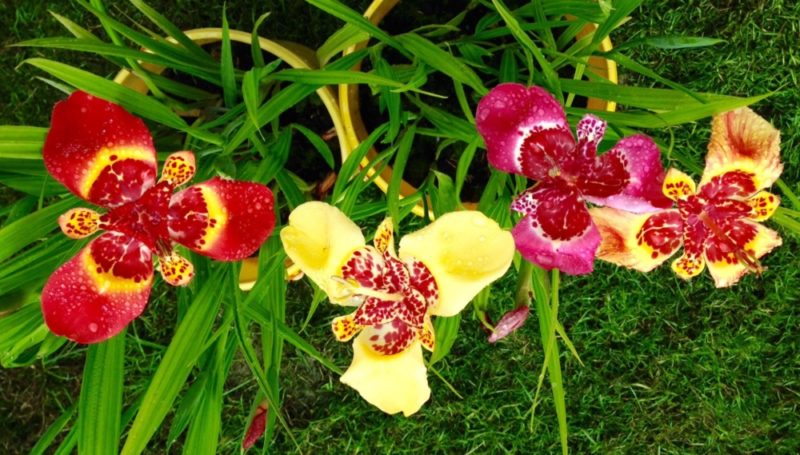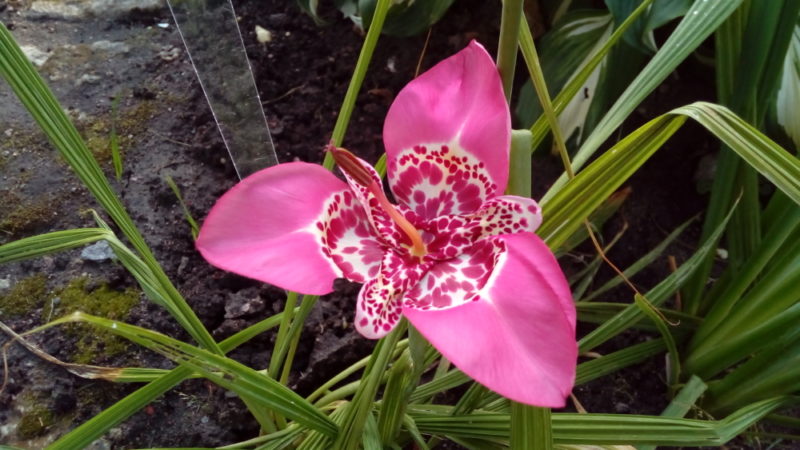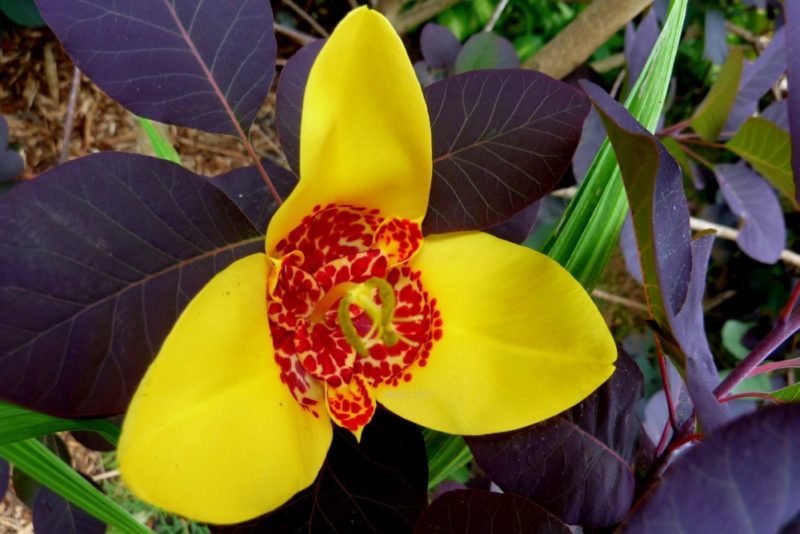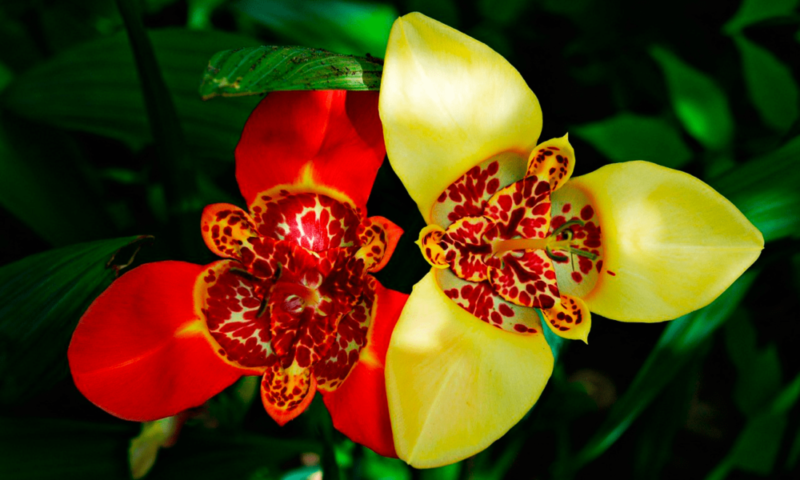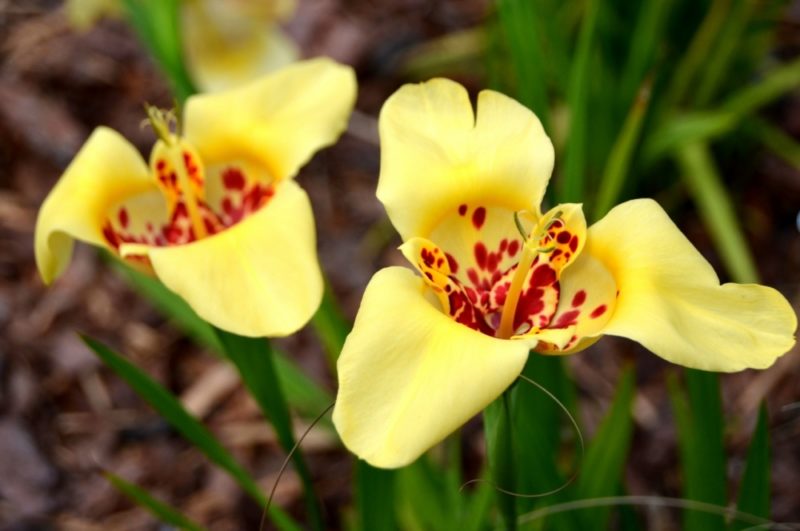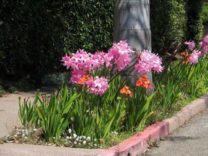In July or August, you can see a bright flower called “tigrdia” on the flower beds. Those flower growers who are familiar with an exotic plant are happy to plant it annually, having mastered simple agricultural technology. Planting tigridia in the open ground and caring for this unusually beautiful flower are similar to those for gladioli.
Material Content:
Description of species and varieties of plants
The bulbous perennial plant of tigridia (Tigridia) belongs to the Iris family. The flower resembles a tulip and a lily at the same time, but differs in a bright color of the pharynx and a corolla with three large petals. The plant is thermophilic and hibernates in open ground only in the southern regions of Russia.
Of the 20 known natural species, peacock tigridium is most often cultivated. This plant is from 20 to 75 cm tall with an irregularly shaped corm. Leaves are sword-shaped with longitudinal folds. From one corm in the summer grows from 3 to 5 peduncles with several buds that open alternately. The corolla of the flower consists of 6 petals - 3 large external and 3 small, similar in color to the motley pharynx.
Popular varieties:
- "Aurea" - dark yellow flowers with crimson spots;
- "Lilacia" - purple-scarlet flowers with ruby spots;
- "Speciosa" - a bright red corolla with yellow speck in the center;
- "Alba" - a snow-white nimbus with red spots in the center;
- "Karminea" - orange-colored outer petals with yellow specks;
- "Rosalind" - mauve flowers.
Sometimes the seeds and bulbs of a plant are sold using just the name of the color of the flowers. So, for example, you can buy tigridia "Yellow", "White", "Pink" and "Cream".
Tigridia planting in open ground
For the successful cultivation of tigridia, it is important to choose the right place and time of planting. The flower loves sunny areas of the garden with fertile, loose soil of neutral acidity. It grows poorly in heavy, acidic soil.
Corms are planted on a flowerbed in early summer, when the earth warms up well.
To bloom as early as possible, grow bulbs at home starting in March or April. Transplanted specimens in open ground, without violating the earthen lump.
The depth of planting in the hole should be at least 10 cm from the bottom of the bulb, the distance between the plants is about 15 cm. Several corms are placed next to them to grow several peduncles, and the flowering will be longer and more plentiful.
In the northern latitudes, cultivation in flower pots is practiced. They plant several bulbs together, and in the summer they take out a pot of plants into the garden and bury them in the open ground. Autumn again brought into the house, and continue to care. With this approach, the vegetation period of plants is extended by 2 months, it is in the autumn period that the bulbs grow most intensively.
Important flower care tips
Tigridia responds well to care and attention. It must be watered, fed with fertilizers, loosen the soil in the flower bed, remove weeds. Flower care includes soil mulching and preventative treatments for diseases and pests.
For normal development and flowering, the plant needs abundant watering, daily in dry weather.
- Watering. On 1 m2, flower beds spend 1 bucket of water so that the soil is wet to a depth of about 30 cm.
- Loosening. If the flower bed is not covered with a layer of mulch from sawdust, straw, humus or peat, after each watering the soil is loosened.
- Garter. The stems and leaves of the flower need a garter, otherwise they decay, lie down on the ground, have a not very attractive appearance.
- Top dressing. Contribute as it grows, respectively, in the vegetative phase in which the plant is located. In the spring, complex fertilizers are required containing equal parts nitrogen, potassium and phosphorus. With the advent of peduncles, the need for nitrogen disappears, they continue to feed only potassium and phosphorus with the addition of the necessary trace elements. In mid-August, all feeding is stopped.
Bright flowers will decorate any landscape design. It is a pity that they fade after 8 or 10 hours after the opening of the buds, but they are replaced by new ones. Tigridia blooming in July will have time to yield seeds. Ripe boxes are collected before the start of frost. If seeds are not needed, it is advisable to cut off wilted flowers so that the plant does not expend unnecessary forces.
When and how to dig a plant
Tigridia does not like cold, if you leave the bulbs in the winter on a flower bed, they will die. The plant is dug up in the fall, from mid-September to the onset of frost. It is necessary to wait for the withering of the aerial part, which will be evidence of the ripening of the bulb.
Dig tigridia for the winter, preferably on a dry autumn day with a shovel.
The aerial part of the plant is cut off with secateurs at 1/3 of the length, corms extracted from the ground are placed for drying at room temperature.
Winter preparations
14 days after digging in the corms, the roots are trimmed and the remains of the stems are shortened to 2 cm. Before final drying, they are treated in a 0.1% solution of Fundazole or potassium permanganate.
After a month, tigridium is ready for winter storage at a low temperature (up to +5 ° C). Bulbs do not have protective scales, therefore, in a dry room, filling them with sand gives good results. At high humidity, it is better to store in a nylon grid, hanging at a height.
Breeding methods
Bulb propagation is most often practiced, but it can also be done with seeds. With the seed method, flowering plants can be obtained after 6 months from the day of sowing.
Young bulbs are separated from the common nest 5 days before planting in a flower bed or in seedling pots, the seeds are sown in mid-winter.
Propagation by seed:
- Soaking and stratification are not required.
- Sowing is carried out in a mixture of peat of neutral acidity and sand.
- The optimum germination temperature is 20 - 25 ° C.
- When seedlings appear, Sentsi must be peaked in separate planting tanks or peat pots.
Seedlings are planted on a flower bed without breaking an earthen lump in early summer.
Seedlings have very sensitive roots that cannot be damaged.
Protection against diseases and pests
Storage of tigrid bulbs in winter is often accompanied by spoilage and decay. To avoid grief and loss, it is advisable to carry out fungicide treatment of all dug up plants. During the growing season, tigridia can also become infected with various infectious and non-infectious diseases or suffer from pests.
Common fungal diseases:
- Fusarium Excess nitrogen fertilizers in the soil and its waterlogging contributes to infection. The infected plant bends, its stems hang, flowering is late, and the flowers are small and dark.
- Septoria It develops on heavy acidic soils. In late summer, brown spots appear on the leaves with a dark border and black specks in the center. The dug out bulbs of diseased plants have spots of gray and tan. During storage, diseased corms dry completely, turn black.
- Penicillus rot. When storing onions appear bluish-green spots. More often, the disease develops in humid rooms with poor ventilation.
For the prevention of fungal diseases of tigridia, prophylactic treatments with fungicides and copper-containing preparations are carried out during the growing season.
For planting, only healthy bulbs are selected, without spots and traces of rot.
Various pests willingly parasitize on the plant:
- thrips;
- cabbage scoops;
- onion mites;
- a bear;
- wireworm;
- slugs.
Insectoacaricides are used to combat them. The slugs and caterpillars of the cabbage scoops are harvested by hand, bait is made for the bear and wireworm. To prevent the infection of plants with thrips, before planting the bulbs are soaked for 2 hours in water with garlic juice.
Pests can become carriers of viral diseases. Having noticed mosaic spots on the leaves, diseased plants are dug up and destroyed.
Use in landscape design
Group plantings of bright tigridium on a green lawn look beautiful. It is undesirable to place other bright, flowering plants nearby. A good background for flowers will be created by conifers, boxwoods, green derain.
Tigridia is planted next to artificial ponds in the garden, they make borders and garden paths. The flowers are combined with soil protectors - arabis, thyme, awl-shaped phlox, low stonecrops.
It is advisable to grow tigridia in central Russia in flower pots. With this option, planting the bulbs will have time to gain the necessary mass by the end of the growing season, they will be better preserved in the winter, which means that the flowering of the crop will be more plentiful and beautiful.


